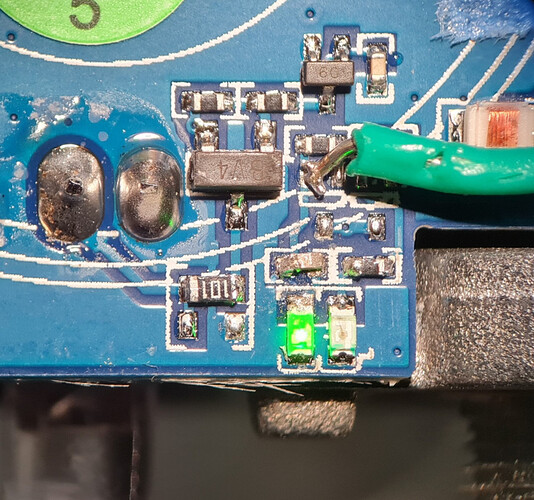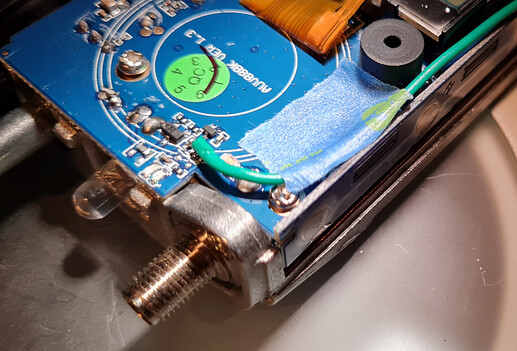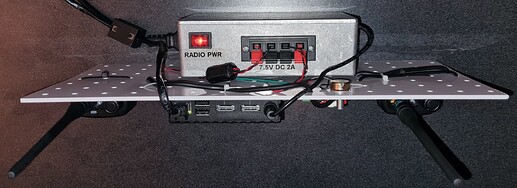A really nice build provided by NR9V-
"After a bit of R&D I have managed to build a high-quality Full-Duplex AllStarLink Node using readily available FCC-certified components, no mods/hacks or soldering required, that can be built by anyone with basic computer skills (though if your cousin / neighbor / ham buddy happens to be a Linux wiz that could be good too). AllStar has been around a long time and nodes have been built in some interesting ways but I’ve seen no previous mentions online of anyone having been able to do all the above with professional-grade audio and RF quality, power supply, microPC, audio interface, and node radio(s), all for under $200. Short 1-minute demo video:
For more info or any questions post a comment below or email me on my QRZ address. Also see this thread for notes on an earlier node I built using an RPi4 and a Yaesu FT-530 HT for the node radio. To summarize my findings:
-
There’s no reason to settle for low-quality half-duplex commercial nodes with noisy SA818 RF modules, cheap CM1xxB audio chips, and closed-source HamVOIP software.
-
There’s no need to use overpriced/hard-to-find Raspberry Pis for a node computer. Dell 3040 and other Thin Client / Micro PCs are widely available for $50 or less on ebay, and have the same low power consumption as an RPi4 (5V 3A) but with more features and built-in eMMC/SSD memory.
-
AllStarLink.org has excellent documentation and support making it very easy to build your own node on Intel/AMD or RPi platforms. ASL is 100% open-source with a huge ham community including many experts who have used it for years with complex interlinked repeater systems.
-
There’s no longer any good reason to use non-FCC-certified Baofeng radios or hack them apart to access a COS line. ASL’s usbradio driver provides reliable COS (RX Audio) detection using the carrierfrom=vox mode. (Note that ASL has a hardcoded 2000mS voxhangtime but I put in a pull request to make that configurable, and I set to 500mS in my usbradio.conf files.)
-
The Retevis RT85 are great radios available for only ~$50 for a pair on amazon with free shipping. They are FCC-certified - ensuring less chance of causing or receiving RFI/EMI, and are known as “Baofeng-killers” due to their excellent performance and super-low price. They are also sold under other names/variations such as the QRZ-1 and TYT TH-UV88.
-
Full-duplex nodes enable more interactive and more efficient communications, prevent doubles and echoing, with telco-grade VOIP communication quality built on the Asterisk open-source PBX platform and Debian Linux.
-
Other radios you use to talk to the node can be half-duplex but it’s better if they support cross-band full-duplex such as a Yaesu FT-470, FT-530, Kenwood TH-72A or a number of other models. Full-duplex radios are also great for satellite communications. An online search for “cross band full duplex HTs” will turn up several good links.
-
AllStar works really well with Full-Duplex radios because it does not echo your transmit audio back into your receive audio. Thus you only hear what’s on the remote node/repeater you’re connected to (minus your own outgoing audio), so it works just like talking on a speakerphone - true full-duplex comms with no echoes, delays, or feedback.
-
You can also use full-duplex smartphone VOIP/IAX apps with the node or even a VOIP phone.
-
AllStar nodes also support EchoLink with a simple cfg setting. You can then access the EchoLink network from your HT or mobile radio rather than having to use the phone app.
-
The DVSwitch distribution of ASL supports bridging to digital modes such as P25, D-STAR, YSF, DMR, etc.
-
Using HTs for node radios provides high audio quality while having low power consumption and being simple, compact, inexpensive, and putting out only as much power as you need to cover your QTH and within a couple miles. (Some nodes use mobile radios but those use much more power and usually won’t go below 5 Watts.)
-
The Masters Communications DRA-30 provides excellent audio quality at a reasonable price and is available in various configurations (kit / assembled, different case options).
-
MicroPCs such as the Dell 3040 have a power button so you can start or cleanly shut down a node simply by pressing the power button, and they have a Real-Time Clock (RTC) IC which enables a node to power itself on and off on a schedule (configurable in BIOS or in a cron entry), which can further reduce power consumption and eliminate the cost of a separate AC timer. Power to the radios can also be gated by the 5V line on one of the USB Ports.
Installing ASL on a 3040 is not hard if you’re experienced in building/maintaining PCs. The 3040’s have a UEFI-only BIOS that needs the boot file in a specific place. To make a UEFI USB drive just format it as FAT32 and copy the files over. Conveniently the Intel/AMD ASL install image is based on Debian Linux which happens to have the boot file where the 3040 expects it. Once the install finishes to the 3040 internal flash, it won’t boot, but with a UEFI clonezilla USB or other Linux tools you can boot the local OS and then copy the /boot/efi/EFI/debian/shimx64.efi file to /boot/efi/EFI/BOOT/BOOTX64.EFI and it then boots fine. After fixing that the rest of the AllStar setup process is the same as on an RPi.
The Intel/AMD ASL image is different from the RPi image in that the latter just goes on an SD Card, into the RPi, and the install is done. The former however is an installer image, intended to boot on a removable device and install Debian and ASL on an internal device (or possibly on a separate removable USB/SDCard). The Debian installer has about 10 different options it will ask, so if you’re not an IT expert you might want to refer to some online forums to make sure you install to the MicroPC’s internal flash drive, overwriting all existing partitions.
Most HTs need a well-filtered DC power supply, as they’re designed to run primarily on battery power and probably don’t have much if any filtering or regulation. HTs will run much cooler on 7-8V and should not be run any higher than that for high duty cycle node TX. It’s easy to find inexpensive linear DC power supplies or inexpensive (~$5) step-down linear regulator circuits on ebay that have a variable voltage regulator IC, heat sink, filter capacitors, and terminal block connections. A larger filter cap eg. 10,000uF can further reduce any power supply noise if needed. I get power to the RT85’s from the power supply using Retevis/TYT “battery eliminator” adapters, which are available for ~$12-15 ea. online, but to save a few $ you could just solder power wires onto the 2 contacts on the back of the radio. You could also run the HTs on their batteries but for a node that will be transmitting a lot it’s probably better to not constantly charge and discharge them, or have the battery die during a longer QSO or net. If you already have a 12V battery system in your shack, that could provide plenty of clean power, but HTs can overheat if run at high duty cycle on 12+V (even if on the low power setting).
Making a cable to go from a DB9 to 2x 2.5mm plugs and 1x 3.5mm plug can be a bit of a hassle if you want it to look pretty, or, just pick up an old DB9 cable, cut it in half and splice on some aux cables. That’s a lot easier than soldering onto DB9 and mini-phone plugs. With a small terminal block there’s no need to solder anything.
Wiring - DRA-30 to Kenwood, Retevis, TYT, QRZ, etc. HTs:
DB9 Pin 1 — TX HT 3.5mm Ring (Tx Audio)
DB9 Pin 3 — TX HT 3.5mm Sleeve (PTT)
DB9 Pin 6 — TX HT 2.5mm Sleeve (Ground)
DB9 Pin 5 — RX HT 2.5mm Tip (Rx Audio)
DB9 Pin 9 — RX HT 2.5mm Sleeve (Ground)
Lastly you’ll need some ferrite cores on at least some of the cables. Definitely one on the USB cable, and one on the audio cable going to the RX HT. The Laird 28A2029-0A2 (Digi-Key Part Number 240-2077-ND) work well and have enough room to allow cables to be wrapped 2 or 3 times. They are only ~$2 ea. in Qty’s of 10, and these often come in handy for other things.
Once your node is up and running you could mount things in some sort of enclosure, maybe a rack-mount shelf, or a clear plastic carry case. There are many ways that could be done. For a home node you don’t really need a case, just set everything on a shelf in the closet and you’re good to go, and can control the node from any web browser using the included Allmon or Supermon web apps.
Be sure to set up your node RX radio with Tone Squelch enabled, to prevent possible QRM from causing your node to TX. I would not use CTCSS on the TX radio though, so you’ll be able to hear other stations if someone happens to be on the same frequency. Also check your local 2m and 70cm band plans (eg. in Southern California TASMA.org and SCRRBA.org) to find simplex frequencies specifically intended for analog FM hotspots so you won’t possibly interfere with repeaters or calling frequencies.
By setting up the MicroPC BIOS to turn On by default after power is applied, and because the RT-85’s have a regular analog volume knob with on/off switch, everything can be placed inside a carrying case with no access needed to the PC or radios once they have been configured. You can then have a single power switch mounted in the case and either a 12V PowerPole or IEC AC inlet. One switch then easily turns everything on and off. If you opt to run it off 12V you’d need a couple step down regulators to drop the 12V to 5V for the PC and ~7-8V for the radios, or if you run AC into the enclosure you can use the power adapter that came with the PC and a 12V 1-2Amp variable linear power supply for the radios.
Feel free to comment or email me with any questions. I can also build custom nodes for reasonable prices, and will be listing some full-duplex nodes on various sites - look for “full-duplex AllStar node” and be sure to only buy products made and supported by reputable ham(s) using high-quality FCC-certified components. 73, NR9V"

![[IMG]](https://community.allstarlink.org/uploads/default/optimized/2X/8/8ff4fc001296a5e3bde732138d5b896a8a5c9144_2_395x500.jpeg)
![[IMG]](https://community.allstarlink.org/uploads/default/optimized/2X/b/b57ebbfcfd5266818d3cd8a395140451d0ff56f9_2_690x447.jpeg)
![[IMG]](https://community.allstarlink.org/uploads/default/optimized/2X/6/65630d7db2cfec44dfaff550d69843df4dd426ad_2_690x435.jpeg)








